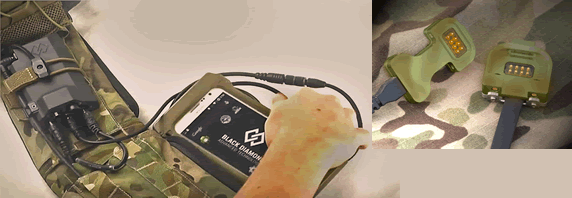The Future Soldier is Already Here
High-performance interconnects that transmit power, data, and signal in military-grade radios, tablets, GPS systems, and headsets are helping military personnel fulfill their duties and get home safely.
By Amy Goetzman

We’re hearing the term “future soldier” a lot lately. If that sounds like a fancy name for robot, you wouldn’t be entirely off-base; tens of thousands of drones and other robotics are on battlefields around the world. But they aren’t the future soldier. That term refers specifically to humans endowed with superhuman capabilities, thanks to high-tech, lightweight, soldier-worn equipment. Naturally, this equipment depends on specialty connectors. We talked with Wayde King, product manager at ITT Cannon, and Bob Stanton, director of technology at Omnetics, to find out more.
Connector Supplier: What is the future soldier? What technologies does this concept include?
Wayde King: The term “future soldier” is used to describe a range of soldier-worn technology, equipment, and devices that increase battlefield effectiveness. Anything a soldier touches, wears, navigates, or communicates with requires lightweight, durable, and reliable connections.
Bob Stanton: Many different technologies are being adapted around the world. One example: Italy began developing the Soldato Futuro soldier system a few years ago. Their emphasis spanned from helmet to clothing, weapons, and communications to new electronics. They selected nano circular connectors and micro-connectors for a lightweight, small form factor plus a smaller diameter cable that flexed easily when being worn. European and US future soldier programs are demanding similar improvements for today’s armies. Much of the electronics seems to include “on or in” cable and connectors that fit with the clothing worn. Much of the need is for keeping constant communications, providing positioning and image material to the individual soldier on the ground and much of the electronics are aimed at well established, but high-performance signal processing and data handling.
What new connector design features are coming into the market to meet the demands of the military market?
King: Three trends are contributing to connector innovation for the soldier wearables market. Connectivity: There’s an increasing need for high-speed data, signal, and power to help soldiers stay connected, no matter the environment. Water Submersion: The demand for interconnect solutions that can withstand water ingress or water submersion is becoming increasingly important to help our warfighters stay connected in harsh environments. Robust Shielding: With multiple peripherals all transferring data and external signals to a soldier’s equipment, soldier-worn interconnects must provide a high level of shielding to prevent radiated emissions and susceptibility.
Stanton: Many designers ask for power plus high-speed digital processing within the same cable to reduce the number of individual wires on the soldier. SWaP (size, weight, and power) demands have driven growth in hybrid or mixed-signal connectors and cables. A highly used smaller-gauge cable with nano-circular connectors was specifically made for soldier-worn applications. Many designers also ask for waterproof or splash-proof sealing with easy disconnection.
How does the connector industry work with the military to develop the technologies it needs?
King: From tablets and handheld radios, to GPS systems and headsets, soldier-worn applications are constantly changing and increasingly sophisticated, creating a need for customizable connectors that work with existing technology and keep pace with advancements. The development of our soldier wearable connectors is largely driven by voice of the customer (VoC) feedback and input, along with our legacy in the design and manufacturing of customized interconnects for military applications.

Omnetics’ round connectors, utilized by Black Diamond, use pin-and-socket technology that has been tested to perform to military performance specifications. Omnetics’ new Future Soldier flat connector system (inset) disconnects quickly and is customer-colored to blend with uniforms and equipment.
Stanton: The military industry often holds design conferences or meetings with key suppliers. A current series of designs are evolving called “flat interconnects” that are aimed at fitting within clothing loops. The goals include quick disconnection and low profiles to protect the troops from injury or getting tangled or caught when traveling through natural environments. Colors are often specified for soldier-worn equipment as well, and this has become an important consideration for the connector designer. Some products need connectors that are dark black, non-shiny, and resistant to salt and rust.
Many MIL-spec connectors are designed for easy cleaning in the field. Tell me more about this capability.
King: Soldiers operate in a wide range of terrains and harsh environments, so their equipment is constantly exposed to elements like dust, dirt, mud, and water. Cannon Breakaway functionality, which is featured on our Nemesis II CBA, allows soldiers to quickly clean the face of the connector and connect their devices in a matter of seconds — minimizing equipment damage and helping them stay better connected and better protected in the field.

The ITT Nemesis II CBA and HSC 20+M miniature circular connectors are designed and tested for water submersion to 20m (65.6ft).
Stanton: When the connector is open and exposed in the battle environment, dust and dirt can fill the connector cavities and surround the pins and sockets used for routing signals. Most field connectors are designed with a solid contact pogo pin system to ensure rugged performance and easily cleaning. Snap locks and seal rings are also common. Flat soldier-worn and nano-sized circulars are designed to prevent intrusion of dust and dirt when they are closed and connected. The best cleaning procedure in the field is a quick horizontal brush-off.
Tell me about fabric interconnects.
King: Fabric connectors are an innovative solution designed to seamlessly integrate onto the fabric of a smart vest where most of a soldier’s network is housed, reducing its overall weight and complexity.
Stanton: The concept is very viable through fiber cabling if the portable Ethernet is capable of switching rapidly enough to select signals and then route them through the fiber. This process has me reminiscing of the early ATM (asynchronous telecom modulation) techniques, where a few wires were used to send multiple phone calls simultaneously by cutting each portion of the message into packets and mixing them during transmission. They are then un-coded and put back together to offer the listener on the other end a complete sentence. To date, we don’t seem to have that much info being sent to and from larger data sources to each soldier on the ground.
What are the key challenges the connector industry is working to solve for military customers?
King: Two of the key challenges include water submersion and mobility. We’re an industry leader in the development of connector solutions that offer protection from water submersion and moisture. When you consider that the average warfighter carries between 87 and 127lbs (39 to 57kg) of gear and equipment, every ounce matters. Our engineering team has designed lightweight, miniaturized, and high-performance interconnects that help lighten the load.
Stanton: Most military systems are worried about cyber intrusion. Protection of signals being routed from one place to another can be monitored and/or disrupted using EMI-type signaling. I believe shielding or filtering will become a much larger factor in the coming era. Also, some countries want to monitor the health of their warriors. Biosensor technologies are being included in soldier-worn electrical networks to provide constant positioning and personal health info, as well as sending data to and from the soldier. As always, there is a demand for smaller, lighter, more portable, higher-speed digital data.
What military equipment has the most potential to migrate to the civilian market?
King: Radios with network capabilities, push-to-talk (PTT) devices, and integrated tablets all have crossover potential for the civilian or business-to-business market. Interconnect solutions that are used to transmit data, power, and signal in a number of different soldier-worn devices are of interest to the first responder market.
Stanton: A network of biosensors and position indicators would transfer immediately to the safety, fire, and police protection industry. As these sensors develop and the price comes down, I also see them being used in extreme sport clothing and professional hockey and football uniforms.
Interested in a specific market? Click a market below for current articles and news.
Automotive, Consumer, Industrial, Medical, Mil/Aero, Datacom/Telecom, and Transportation
- Where in the World is Amphenol LTW’s Luc Kan? - April 23, 2024
- TE Connectivity’s Sustainability Efforts Pay Off - April 23, 2024
- What is a VGA Connector? - April 23, 2024












